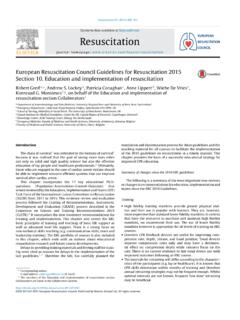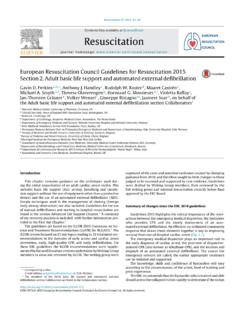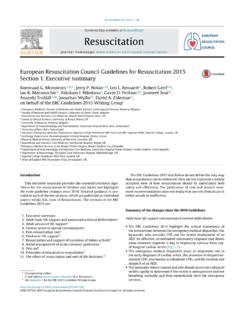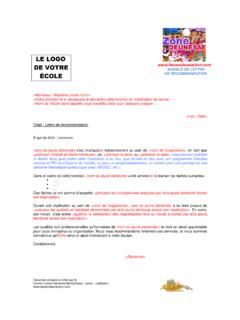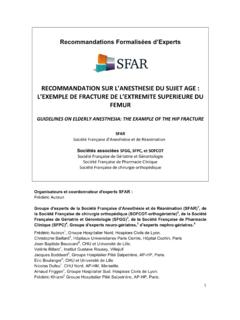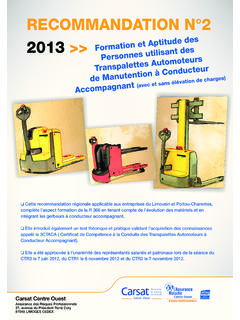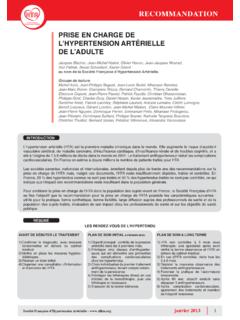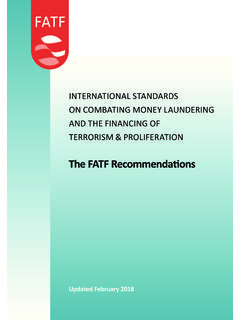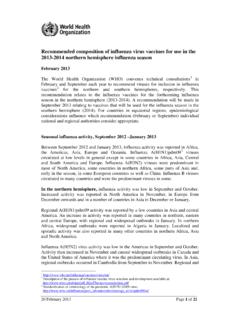Transcription of Summary of the main changes in the Resuscitation …
1 Summary of the main changes in the Resuscitation GuidelinesERC guidelines 2015 Published by: European Resuscitation Council vzw, Emile Vanderveldelaan 35, 2845 Niel, BelgiumWebsite: Email: Tel: +32 3 246 46 66 European Resuscitation Council 2015 Anaphylaxis algorithm - reproduced with permission from Elsevier Ireland license number 3674081014315 Hyperkalaemia algorithm - reproduced with permission from Renal Association and Resuscitation Council (UK)All rights reserved. We encourage you to send this document to other persons as a whole in order to disseminate the ERC part of this publication may be reproduced, stored in a retrieval system, or transmitted in any form or by any means, electronic,mechanical, photocopying, recording or otherwise for commercial purposes, without the prior written permission of the : The knowledge and practice in cardiopulmonary Resuscitation is evolving constantly. The information provided in these guidelines is for educational and informational purposes only.
2 This information should not be used as a substitute for the advice of an appropriately qualified and licensed healthcare provider. Where appropriate, the authors, the editor and the publisher of these guidelines urge users to consult a qualified health-care provider for diagnosis, treatment and answers to their personal medical questions. The authors, the editor and the publisher of these guidelines cannot guarantee the accuracy, suitability or effectiveness of the treatments, methods, products, instructions, ideas or any other content contained herein. The authors, the editor and/or the publisher of these guidelines cannot be liable in any way for any loss, injury or damage to any person or property directly or indirectly related in any way to the use of these of the changes since the 2010 GuidelinesAdult basic life support and automated external defibrillation The ERC guidelines 2015 highlight the critical importance of the interactions between the emergency medical dispatcher, the bystander who provides CPR and the timely deployment of an AED.
3 An effective, co-ordinated community response that draws these elements together is key to improving survival from out-of-hospital cardiac arrest. The emergency medical dispatcher plays an important role in the early diagnosis of cardiac arrest, the provision of dispatcher-assisted CPR (also known as telephone CPR), and the location and dispatch of an AED. The bystander who is trained and able should assess the collapsed victim rapidly to determine if the victim is unresponsive and not breathing normally and then immediately alert the emergency services. The victim who is unresponsive and not breathing normally is in cardiac arrest and requires CPR. Bystanders and emergency medical dispatchers should be suspicious of cardiac arrest in any patient presenting with seizures and should carefully assess whether the victim is breathing normally. CPR providers should perform chest compressions for all victims in cardiac arrest.
4 CPR providers trained and able to perform rescue breaths should combine chest compressions and rescue breaths. Our confidence in the equivalence between chest compression-only and standard CPR is not sufficient to change current practice. High-quality CPR remains essential to improving outcomes. The guidelines on compression depth and rate have not changed. CPR providers should ensure chest compressions of adequate depth (at least 5 cm but no more than 6 cm) with a rate of 100 120 compressions min 1. After each compression allow the chest to recoil completely and minimise interruptions in compressions. When providing rescue breaths/ventilations spend approximately 1 s inflating the chest with sufficient volume to ensure the chest rises visibly. The ratio of chest compressions to ventilations remains 30:2. Do not interrupt chest compressions for more than 10 s to provide ventilations.
5 Defibrillation within 3-5 min of collapse can produce survival rates as high as 50-70 %. Early defibrillation can be achieved through CPR providers using public access and on-site AEDs. Public access AED programmes should be actively implemented in public places that have a high density of citizens. The adult CPR sequence can be used safely in children who are unresponsive and not breathing normally. Chest compression depths in children should be at least one third of the depth of the chest (for infants that is 4 cm, for children 5 cm).12 ERC GuidelinesSummary of the changes since the 2010 guidelines A foreign body causing severe airway obstruction is a medical emergency and requires prompt treatment with back blows and, if that fails to relieve the obstruction, abdominal thrusts. If the victim becomes unresponsive CPR should be started immediately whilst help is advanced life supportThe ERC 2015 ALS guidelines emphasise improved care and implementation of the guidelines in order to improve patient focused outcomes.
6 The key changes since 2010 are: Continued emphasis on the use of rapid response systems for care of the deteriorating patient and prevention of in-hospital cardiac arrest. Continued emphasis on minimally interrupted high-quality chest compressions throughout any ALS intervention: chest compressions are paused briefly only to enable specific interventions. This includes minimising interruptions in chest compressions for less than 5 s to attempt defibrillation. Keeping the focus on the use of self-adhesive pads for defibrillation and a defibrillation strategy to minimise the preshock pause, although we recognise that defibrillator paddles are used in some settings. There is a new section on monitoring during ALS with an increased emphasis on the use of waveform capnography to confirm and continually monitor tracheal tube placement, quality of CPR and to provide an early indication of return of spontaneous circulation (ROSC).
7 There are a variety of approaches to airway management during CPR and a stepwise approach based on patient factors and the skills of the rescuer is recommended. The recommendations for drug therapy during CPR have not changed, but there is greater equipoise concerning the role of drugs in improving outcomes from cardiac arrest. The routine use of mechanical chest compression devices is not recommended, but they are a reasonable alternative in situations where sustained high-quality manual chest compres-sions are impractical or compromise provider safety. Peri-arrest ultrasound may have a role in identifying reversible causes of cardiac arrest. Extracorporeal life support techniques may have a role as a rescue therapy in selected patients where standard ALS measures are not arrest in special circumstancesSpecial causesThis section has been structured to cover the potentially reversible causes of cardiac arrest that must be identified or excluded during any Resuscitation .
8 They are divided into two groups of four - 4Hs and 4Ts: hypoxia; hypo-/hyperkalaemia, and other electrolyte disorders; hypo-/hyperthermia; hypovolaemia; tension pneumothorax; tamponade (cardiac); thrombosis (coronary and pulmonary); toxins (poisoning).23 ERC GuidelinesSummary of the changes since the 2010 guidelines Survival after an asphyxia-induced cardiac arrest is rare and survivors usually have severe neurological impairment. During CPR, early effective ventilation of the lungs with supplementary oxygen is essential. A high degree of clinical suspicion and aggressive treatment can prevent cardiac arrest from electrolyte abnormalities. The new algorithm provides clinical guidance to emergency treatment of life-threatening hyperkalaemia. Hypothermic patients without signs of cardiac instability can be rewarmed externally using minimally invasive techniques. Patients with signs of cardiac instability should be transferred directly to a centre capable of extracorporeal life support (ECLS).
9 Early recognition and immediate treatment with intramuscular adrenaline remains the mainstay of emergency treatment for anaphylaxis. A new treatment algorithm for traumatic cardiac arrest was developed to prioritise the sequence of life-saving measures. Transport with continuing CPR may be beneficial in selected patients where there is immediate hospital access to the catheterisation laboratory and experience in percutaneous coronary intervention (PCI) with ongoing CPR. Recommendations for administration of fibrinolytics when pulmonary embolism is the suspected cause of cardiac arrest remain environmentsThe special environments section includes recommendations for the treatment of cardiac arrest occurring in specific locations. These locations are specialised healthcare facilities ( operating theatre, cardiac surgery, catheterisation laboratory, dialysis unit, dental surgery), commercial airplanes or air ambulances, field of play, outside environment ( drowning, difficult terrain, high altitude, avalanche burial, lightning strike and electrical injuries) or the scene of a mass casualty incident.
10 A new section covers the common causes and relevant modification to resuscitative procedures in patients undergoing surgery. In patients following major cardiac surgery, key to successful Resuscitation is recognising the need to perform immediate emergency resternotomy, especially in the context of tamponade or haemorrhage, where external chest compressions may be ineffective. Cardiac arrest from shockable rhythms (ventricular fibrillation (VF) or pulseless ventricular tachycardia (pVT) during cardiac catheterisation should immediately be treated with up to three stacked shocks before starting chest compressions. Use of mechanical chest compression devices during angiography is recommended to ensure high-quality chest compressions and to reduce the radiation burden to personnel during angiography with ongoing CPR. AEDs and appropriate CPR equipment should be mandatory on board of all commercial aircraft in Europe, including regional and low-cost carriers.)
